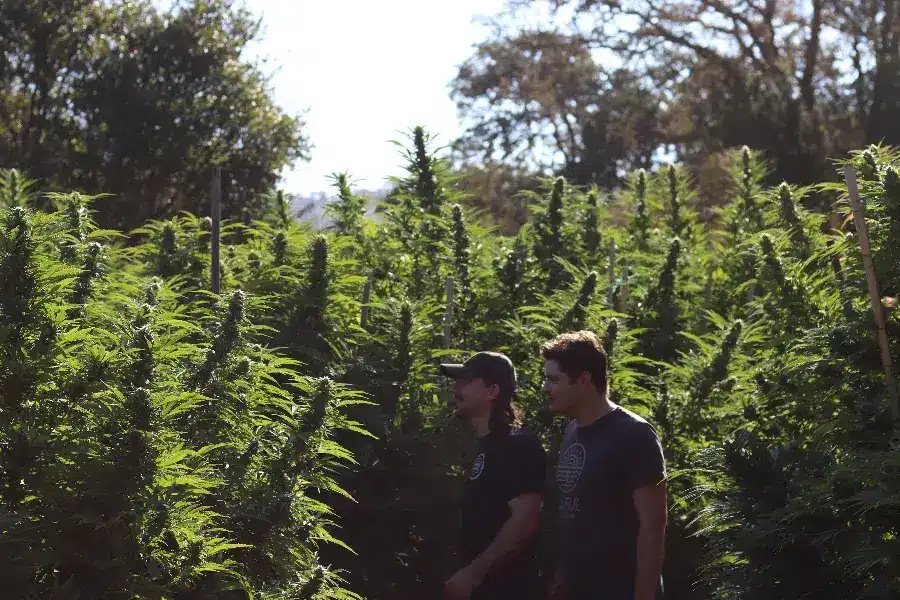
Imagine a world where warm sunlight nourishes crops unlike any other. A light breeze wafts the sweet fragrance of blossoming flowers across endless fields. It is the realm of growing marijuana outside — a practice that has been around for centuries.
Growing cannabis outdoors is not just a means to an end. It is an entire art that requires a deep understanding of farming best practices. The following factors need to be carefully considered:
- The needs of the plant
- Preferred habitat
- Best growing methods
It’s a dance between nature and the cultivator, a symbiotic relationship. But the result is a truly remarkable product.
In this article, we’ll dive into growing outdoor cannabis. We’ll look at the benefits and challenges of growing outdoor cannabis. Join us as we uncover the secrets of growing outdoor cannabis.
The Unique Advantages of Outdoor Cannabis Cultivation
Growing cannabis outdoors has a unique set of advantages. And they’re what sets it apart from growing indoors. Of course, growing indoors gives you more control over your environment. Let’s take a look at some of the key benefits of growing cannabis this way.
Natural Sunlight
If you are thinking about how to grow marijuana outside, you need sunlight. The sun provides the full spectrum of light that cannabis plants need to thrive. It is what promotes their healthy growth and development. Outdoor plants can grow larger and produce higher yields than those grown indoors.
Cost-Effective
Growing cannabis outdoors is usually more cost-effective than growing indoors. Those who grow cannabis outdoors can utilize natural resources such as:
- sunlight
- rain
- soil
It reduces the need for expensive equipment. Consider how much you’ll save on lamps, ventilation systems, and other devices. It makes growing naturally attractive for those looking to minimize costs.
Environmentally Friendly
Want to know tips for growing marijuana outside? Growing outdoors is not only positive for the growth of the plant. It’s also more environmentally friendly than traditional growing. It reduces the carbon footprint associated with indoor growing. The traditional version relies heavily on electricity for lighting and climate control. Plants grown outdoors can benefit from natural pest control methods. It reduces the need for chemical pesticides.
Larger Plant Size
Outdoor cannabis plants can reach impressive sizes. They have enough space for roots and branches to spread. Therefore, they can grow several feet tall and wide. This results in higher yields per plant. It is especially beneficial for farmers with limited space. Want to maximize your yield? Growing marijuana outside is an option for you!
Enhanced Terpene Profile
Growing outdoors can lead to a richer terpene profile in cannabis plants. Terpenes are aromatic compounds that give cannabis its distinctive flavors and aromas. Exposure to natural elements can enhance the production of terpenes. As a result, you’ll get more aromatic and tasty buds.
Resilience and Adaptability
Outdoor cannabis plants tend to be more resilient and adapted to stressors. They develop a stronger root system. Then, they are better adapted to hardships such as:
- temperature fluctuations
- wind
- pests
This natural resilience can lead to healthier plants and better harvests.
Seasonal Harvests
Growing outdoor cannabis allows for seasonal harvests, which usually occur in the fall. This natural cycle coincides with the flowering stage of the plant. This results in a bountiful harvest of mature buds. Seasonal harvests can be an exciting time for those who grow cannabis outdoors, because they reap the rewards of their hard work and dedication.
The Start of the Outdoor Cannabis Growing Season
The cannabis growing season usually starts in the spring. It is when the weather starts to warm up and the days get longer. At this time, cultivators begin to prepare growing sites and plan for the harvest.
One of the first steps in how to grow marijuana outside is choosing the correct location. Farmers look for sites that receive ample sunlight. At the same time, the site should have good soil drainage and be protected from strong winds. They also consider factors such as:
- privacy
- safety
- protection against possible theft
Once a suitable location has been chosen, cultivators begin preparing the soil. One of the tips for growing marijuana outside is tilling the soil. Choosing the right location and compost to enrich the soil is essential. Some farmers may also have the soil analyzed. It will determine the pH level and nutrient content.
Farmers then obtain seeds or clones of cannabis. They carefully select varieties that are well-suited for outdoor growing. It is essential to consider factors such as:
- climate
- resistance to pests and diseases
- desired yield and potency
Once the danger of frost has passed and the days are longer, cultivators sow seeds or transplant clones to a prepared location for outdoor cultivation. It marks the beginning of the exciting journey of caring for cannabis plants throughout the growing season.
Guidelines for Outdoor Cannabis Cultivation
Growing cannabis in the ground can be a rewarding endeavor. But let’s face it, it requires careful planning and attention to detail. To ensure a successful harvest, there are a few critical tips for growing marijuana outside. Let’s look at these tips and how they contribute to overall plant health and productivity.
Choose the Right Location
Choosing the right location is crucial for growing cannabis outdoors. Look for a location that gets plenty of sunlight, ideally south-facing. The location should also have good air circulation. It will prevent the growth of mold and mildew. Think about the privacy and security of the area. It will protect your plants from unwanted attention.
Prepare the Soil
Healthy soil is essential for vigorous plant growth. Till the soil and remove all rocks, weeds, and debris before planting. Check the pH level of the soil and adjust it if necessary. Cannabis plants thrive in slightly acidic soil with a pH of 6.0 to 7.0. Enrich the soil with organic matter. It can be compost or well-rotted manure. You can improve its structure and nutrient content.
Select Suitable Strains
For growing marijuana outside, choose varieties that are well adapted to outdoor conditions. Sativa-dominant varieties grow taller and do better in warm and humid climates. Indica-dominant varieties, on the other hand, are more resistant to cooler temperatures. They have a shorter flowering period.
Plant at the Right Time
Timing is key when starting an outdoor cannabis grow. Wait until the danger of frost has passed and the days are long enough. It will allow for sufficient sunlight. In most regions, planting takes place between late spring and early summer. Keep an eye on local weather conditions and adjust your planting schedule accordingly.
Water and Fertilize Properly
Cannabis plants require constant moisture. But overwatering can be disastrous. Water the plants deeply and let the soil dry out between waterings. Fertilize regularly using organic or chemical fertilizers. Follow the manufacturer’s instructions, and do not overfeed the plants. Overfeeding can cause root burn and damage to the plants.
Monitor for Pests and Diseases
When considering how to grow marijuana outside, think about regular maintenance. Inspect your cannabis plants regularly for signs of pests and diseases. The most common pests are aphids, spider mites, and powdery mildew. Take preventative measures such as planting companion plants and using natural pesticides. If an infestation occurs, act quickly. It will minimize damage and prevent it from spreading.
Provide Support
Cannabis plants may need support as they grow. The branches should not break under the weight of heavy buds. Use special sticks to provide structural support.
Harvest at the Right Time
Knowing when to harvest cannabis is crucial for optimal potency and flavor. Observe the trichomes on the buds with a magnifying glass. When most trichomes turn from clear to milky or amber, it’s time to harvest. Prune the plants, cut off the buds, and dry them slowly in a cool, dark place.
Typical Errors in Outdoor Cannabis Cultivation
Thinking about growing outdoor cannabis may seem like an easy and entertaining endeavor. But it is not without its challenges. Even experienced farmers can fall victim to common mistakes. And they can affect the health and yield of the plants. Let’s take a look at some common mistakes when growing cannabis and how to avoid them.
Overwatering or Underwatering
One of the most common mistakes when growing cannabis is improper watering. Overwatering can lead to root rot and nutrient deficiencies. Underwatering can lead to stunted growth and wilting. To avoid this, regularly monitor soil moisture levels and water deeply but infrequently. Be sure to let the soil dry out a little between waterings.
Nutrient Imbalances
Another common mistake when growing marijuana outside is the wrong ratio of nutrients. Over-fertilization can lead to root burn and plant damage. Under-fertilization can lead to nutrient deficiencies. It is very important to use a well-balanced nutrient solution. Follow the recommended fertilization schedule.
Inadequate Pest and Disease Control
Outdoor cannabis plants are vulnerable to a variety of pests and diseases. Failure to follow control strategies can result in significant crop damage. Inspect your plants regularly for signs of infestation or infection. Take proactive measures if necessary:
- using natural predators (such as ladybugs to control aphids)
- planting companion plants
- using organic pesticides
Poor Site Selection
Choosing an unsuitable site for growing outdoor cannabis can be detrimental to growth and yield. Planting in a site with insufficient sunlight, poor soil quality, or exposure to strong winds can hinder plant development. Take time to evaluate the characteristics of the site. Choose a location that provides optimal growing conditions.
Know these common mistakes in advance and take proactive steps to avoid them. Then, outdoor cannabis enthusiasts can minimize the risk of failure and increase their chances of a successful harvest. Remember, patience, attention to detail, and a willingness to learn from mistakes are key to mastering the art of outdoor cannabis cultivation.
FAQ
What is the best time of year to start growing marijuana outdoors?
The best time to start growing marijuana outdoors is typically in the spring after the last frost has passed and the days are getting longer.
What type of soil is best for growing marijuana outdoors?
Well-draining, nutrient-rich soil with a pH between 6.0 and 7.0 is ideal for growing marijuana outdoors. Loamy soil amended with compost is a good choice.
How much sunlight do outdoor marijuana plants need?
Outdoor marijuana plants require at least 6 hours of direct sunlight daily, but they thrive with 8 to 12 hours of direct sunlight.
How often should I water my outdoor marijuana plants?
Water your outdoor marijuana plants when the top inch of soil feels dry. Frequency depends on factors like temperature, humidity, and plant size.
How can I improve the yield of my outdoor marijuana plants?
To improve the yield of outdoor marijuana plants, ensure they receive proper nutrition, water, and sunlight. Training techniques like topping and low-stress training (LST) can also increase yields.
